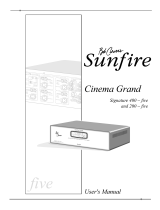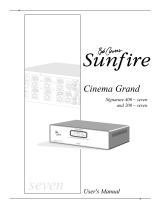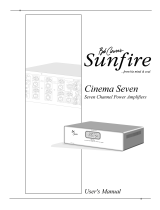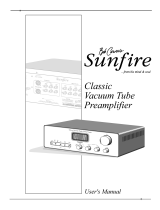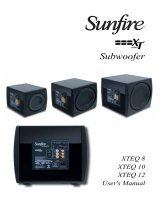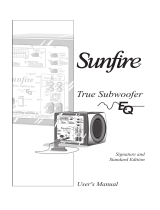Page is loading ...


2
User's Manual
Safety Instructions
1. Read Instructions -– All the safety and
operation instructions should be read before
the Sunfire Component is operated.
2. Retain Instructions — The safety and
operating instructions should be kept for
future reference.
3. Heed Warnings — All warnings on the
Component and in these operating instruc-
tions should be followed.
4. Follow Instructions — All operating and
other instructions should be followed.
5. Water and Moisture — The Component
should not be used near water - for example,
near a bathtub, washbowl, kitchen sink,
laundry tub, in a wet basement, or near a
swimming pool, etc.
6. Ventilation — The Component should be
situated so that its location or position does
not interfere with its proper ventilation. For
example, the Component should not be
situated on a bed, sofa, rug, or similar surface
that may block any ventilation openings; or
placed in a built-in installation such as a
bookcase or cabinet that may impede the flow
of air through ventilation openings.
7. Heat — The Component should be situated
away from heat sources such as radiators, or
other devices which produce heat.
8. Power Sources — The Component should
be connected to a power supply only of the type
described in these operation instructions or as
marked on the Component.
9. Power Cord Protection — Power-supply
cords should be routed so that they are not likely
to be walked upon or pinched by items placed
upon or against them, paying particular attention
to cords at plugs, convenience receptacles, and
the point where they exit the Component.
10. Cleaning — The Component should be
cleaned only as recommended in this manual.
11. Non-use Periods—The power cord of the
Component should be unplugged from the
outlet when unused for a long period of time.
12. Object and Liquid Entry — Care should
be taken so that objects do not fall into and
liquids are not spilled into the inside of the
Component.
13. Damage Requiring Service — The
Component should be serviced only by qualified
service personnel when:
A. The power-supply cord or the plug has been
damaged; or
B. Objects have fallen, or liquid has spilled
into the Component; or
C. The Component has been exposed to rain;
or
D. The Component does not appear to
operate normally, or exhibits a marked
change in performance; or
E. The Component has been dropped, or its
cabinet damaged.
14. Servicing — The user should not attempt
to service the Component beyond those
means described in this operating manual. All
other servicing should be referred to qualified
service personnel.
Safety Instructions

3
User's Manual
15. To prevent electric shock, do not use this
polarized plug with an extension cord, recep-
tacle or other outlet unless the blades can be
fully inserted to prevent blade exposure.
Pour préevenir les chocs électriques ne pas
utiliser cette fiche polariseé avec un
prolongateur, un prise de courant ou une autre
sortie de courant, sauf si les lames peuvent être
insérées à fond sans laisser aucune pariie à
découvert.
16. Grounding or Polarization — Precautions
should be taken so that the grounding or
polarization means of the Component is not
defeated.
This apparatus does not exceed the Class A/
Class B (whichever is applicable) limits for radio
noise emissions from digital apparatus as set
out in the radio interference regulations of the
Canadian Department of Communications.
ATTENTION — Le présent appareil
numérique n'émet pas de bruits
radioélectriques dépassant las limites
applicables aux appareils numériques de
class A/de class B (selon le cas) prescrites
dans le règlement sur le brouillage
radioélectrique édicté par les ministere des
communications du Canada.
WARNING – TO REDUCE THE RISK OF FIRE OR ELECTRIC SHOCK,
DO NOT EXPOSE THIS APPLIANCE TO RAIN OR MOISTURE.
CAUTION: TO PREVENT ELECTRIC SHOCK, MATCH WIDE BLADE
OF PLUG TO WIDE SLOT, FULLY INSERT.
ATTENTION: POUR
ÉVITER LES CHOCS ÉLECTRIQUES, INTRO-
DUIRE LA LAME LA PLUS LARGE DE LA FICHE DANS LA BORNE
CORRESPONDANTE DE LA PRISE ET POUSSER JUSQU’AU FOND.
Safety Instructions

4
User's Manual
Signature and Standard Editions ....................................... 5
Introduction ........................................................................ 6
Unpacking .......................................................................... 7
Signature Edition specifications ......................................... 8
Standard Edition specifications.......................................... 9
Installation ........................................................................ 10
Front panel features......................................................... 11
Rear panel features .................................................... 12-13
System configurations...................................................... 14
Unbalanced inputs, voltage source outputs ................. 14
Balanced inputs, current source outputs...................... 15
Parallel Mono ............................................................... 16
Biwiring, Stereo ............................................................ 17
Biwiring, Mono .............................................................. 18
Biamping ...................................................................... 19
Speaker connections ....................................................... 20
Troubleshooting guide................................................. 21-22
Limited Warranty .............................................................. 23
Service assistance ........................................................... 23
Contents
To find out more about this and other Sunfire products, please visit our website:
www.sunfire.com
Table of Contents

5
User's Manual
Signature and Standard Editions
This manual covers both the Signature
Edition and the Standard Edition of the
Sunfire Series II Amplifiers.
The Signature Edition has more power
output and uses premium quality output
terminals compared to the Standard Edition.
Standard Edition
325 Watts per channel into 8 Ω
650 Watts per channel into 4 Ω
19” wide chassis
Signature Edition
625 Watts per channel into 8 Ω
1250 Watts per channel into 4 Ω
19” wide chassis
Bob Carver’s signature on the
front panel
Signature and Standard Editions
The illustrations in this manual are of the
Signature Edition, but the operational details,
features and connections to loudspeakers and
preamplifiers are the same for both models.

6
User's Manual
Introduction
Dear Friend:
Thank you for purchasing my
Sunfire
two channel power amplifier. I hope you enjoy it and
the music it makes as much as I have enjoyed creating it for you.
This magnificent amplifier represents my very latest thinking - and my best amplifier design
ever. I’ve spent over twenty years developing it, and cannot imagine how I could make it any
better, or refine it any further. No matter what, its performance is, at first, somewhat difficult to
believe.
The
Sunfire
Signature Edition
can produce 625 watts rms per channel into 8 ohms and
1250 watts rms into 4 ohms.
The
Sunfire
Standard Edition
can produce 325 watts rms per channel into 8 ohms, and 650
watts rms per channel into 4 ohms.
The big breakthrough feature of the
Sunfire
Amplifier is its uncanny tracking downconverter,
which uses 18 Herculean Mosfets in the Signature Edition and 12 in the Standard Edition.
The circuit boards are heavy glass epoxy, double sided, with a Faraday shield on the back
side. All resistors in the signal path are 1% tolerance, metal-film. Critical capacitors are film
devices with high dielectric strength and ultra low absorption characteristics. An enormous
Sunfire
power source built around a massive power transformer provides the ultimate muscle for limitless
dynamics.
I could go on and on, but here’s the best part: I’ve included two kinds of left and right outputs:
(1) a standard voltage-source (i.e., near zero impedance) output for all typical applications and
(2) a higher-impedance current-source output, which many prefer for electrostatic, planar mag-
netic, or ribbon speakers. Or you can biwire your system with the voltage source driving the
woofer(s) and the current source driving the upper part of the system. In many cases this provides
by far the best possible interface between the amplifier and the speaker system.
Whichever way you decide to hook up the
Sunfire
power amplifier, it will create a multilayered
soundstage that is deep, wide, three-dimensional, and utterly believable. The optional current-
source output can coax forth a sensuous, delicately detailed musical voice long associated with
low-powered classic tube amplifiers. (The current-source characteristic of vacuum tubes is the
dominant factor in the soundstage delivery of classic tube amplifiers).
Bob Carver, Amplifier Designer, Physicist
Introduction

7
User's Manual
Your Sunfire Amplifier should reach you in
perfect condition. If you do notice any ship-
ping damage, please contact your Sunfire
Dealer immediately.
Gently lift out the unit and remove all the
packing material and accessories. It is
important to save all the packing materials
and the box in case your amplifier ever needs
to be moved or shipped for repair.
Make sure that you keep your sales
receipt. It is the only way to establish the
duration of your Limited Warranty and it may
come in useful for insurance purposes.
Please make a note of your serial number
located on the rear panel:
Serial #:
___________________________
Purchased at:
___________________________
___________________________
___________________________
Date: _______________________
Unpacking
Unpacking

8
User's Manual
Signature Edition Specifications
Signature Edition Specifications
Power Consumption
45W At idle
300W Typical (1/8th power)
1800W Absolute Max (Fuse Limit)
Dimensions
19.0 inches wide
6.5 inches high (including feet)
15.75 inches deep
Weight
39 lbs
Finish
Brushed aluminum and black anodize
Power output
625 watts continuous, per channel,
both channels driven into eight ohms,
from 20Hz-20kHz with no more than
0.5% T.H.D.
Power at clipping, minimum:
1250 watts per channel into four ohms.
2000 watts per channel into two ohms
(time limited basis).
Hum and Noise
-103 dB, A-Weighted
Maximum output current
100 amperes peak to peak per channel
Maximum output voltage
70.7 Vrms
Output impedance
Voltage source: Approximately zero ohms
Current source: Approximately one ohm
Input impedance, RCA inputs
30kΩ
Input sensitivity for rated output
Unbalanced: 2.5 Vrms
Balanced: 2.5 Vrms
Input impedance, XLR inputs
24kΩ, each leg balanced to ground
Female XLR
Pin 1 is ground
Pin 2 is negative (cold)
Pin 3 is positive (hot)

9
User's Manual
© 2001 Sunfire Corporation.
All rights reserved. Sunfire Corporation
reserves the right to improve its products at
any time. Therefore, specifications are subject
to change without notice.
Manual part number : 913-042-00 Rev A
Standard Edition Specifications
Standard Edition Specifications
Power output
325 watts continuous, per channel,
both channels driven into eight ohms,
from 20Hz-20kHz with no more than
0.5% T.H.D.
Power at clipping, minimum:
650 watts per channel into four ohms.
1300 watts per channel into two ohms
(time limited basis).
Hum and Noise
-100 dB, A-Weighted
Maximum output current
80 amperes peak to peak per channel
Maximum output voltage
51 Vrms
Output impedance
Voltage source: Approximately zero ohms
Current source: Approximately one ohm
Input impedance, RCA inputs
30kΩ
Input sensitivity for rated output
Unbalanced: 1.8 Vrms
Balanced: 1.8 Vrms
Input impedance, XLR inputs
24kΩ, each leg balanced to ground
Female XLR
Pin 1 is ground
Pin 2 is negative (cold)
Pin 3 is positive (hot)
Power Consumption
45W At idle
150W Typical (1/8th power)
1800W Absolute Max (Fuse Limit)
Dimensions
19.0 inches wide
6.5 inches high (including feet)
15.75 inches deep
Weight
37 lbs
Finish
Brushed aluminum and black anodize

10
User's Manual
Read and follow all safety instructions
shown on pages 2 and 3.
Observe the following precautions when
choosing a location for your Sunfire Amplifier:
• Protect it from prolonged exposure to
direct sunlight and other direct
sources of heat, such as heating
vents and radiators.
• Do not expose the unit to rain or
moisture. If fluid or a foreign object
should enter the unit, immediately turn
off the power and contact your Sunfire
Dealer.
• Avoid excessive exposure to
extreme cold or dust.
• Do not place heavy objects on top of
the unit.
• Allow adequate ventilation around the
amplifier; do not cover the ventilation
slots.
AC Power Considerations
Ensure that the unit is plugged into an
outlet capable of supplying the correct voltage
specified for your model. The outlet should be
capable of supplying 15 amps for the 120V
model, 8 amps for the 230V model.
Note that the Sunfire Amplifier has no
power switch. It is designed to be turned off, if
desired, using a switched outlet or power
strip.
Care
If you need to clean the front surface, first
turn off the power and then use a slightly
dampened cloth, rubbing with the grain. Be
careful not to scratch the display window.
Connection Tips
Before setting up your new system,
please consider the following :
• Always make sure that your compo-
nents are all turned OFF before
making or changing connections.
• Make sure that the power cords of all
your components are attached to the
same outlet or at least to the same
circuit. This will reduce the possibility
of a ground loop in the system.
Make sure that the total current
draw does not exceed the
current rating of the outlet.
• Use the XLR inputs if your preamplifier
has XLR outputs. These balanced
connections provide superior noise
rejection.
• Whenever possible, keep the power
cords away from the signal cables
or speaker wires to prevent any hum
or interference being heard in the
speakers.
• Choose reliable hookup cables, also
called patch cords or RCA cables. They
should be fully shielded and as short as
possible for the job.
• Do not place your preamp directly on
top of the amplifier. It may pick up hum
from the amplifier’s massive AC power
transformer.
• Some patch cords can be a very tight
fit and there is usually a preferred
method of getting them off, some have
to be removed with a twisting action.
Be gentle or you may damage the
jacks of the amplifier or your other
components.
• Some special patch cords can only be
hooked up in one direction, these are
usually marked with arrows.
• It is usual for the right patch cord plugs
to be red and the left connections to be
white, grey or black. Video connections
are usually yellow.
Installation
Installation

11
User's Manual
Front Panel Features (Signature Edition shown)
Overview
Your Sunfire Amplifier
has two channels
of power amplification combined in one
chassis for the purpose of reproducing music
or video soundtracks. It accepts line level
signals from a controlling preamplifier and
amplifies them to a higher level, suitable for
driving powerful stereo and home theater
speakers.
Meter
The front panel meter indicates the total
energy available from the tracking
downconverter power supply. It is calibrated in
Joules and will normally indicate approxi-
mately 480 Joules for the Signature Edition
and 400 Joules for the Standard Edition. Note
that the needle does not move under normal
use.
Crystal Base
The glass base is intended to ensure
proper airflow under the amplifier. A good
choice for the amp location is centered
between the loudspeakers on the floor, using
the glass base to prevent the carpet from
restricting the airflow. If you choose to place
the unit on a shelf or other hard surface, the
base will isolate the amp from vibration and
will help make an attractive installation.
Illumination
The meter is illuminated by an incandes-
cent lamp operating at a very warm color
temperature. I have been influenced by the
scale lighting of classic electronic equipment
from the 1950’s, with their warm dim glow,
usually with a “headlight effect” from the lamp.
I incorporated that historical look and feel into
this meter lighting. It is decidedly not “evenly
back-lit” with a cool to cold color temperature.
I hope you like my unusual meter lighting
treatment.
The Signature Edition has a switch on the
underside of the unit toward the front. This
gives you the ability to dim the meter lamp to
reduce distractions in a home theater environ-
ment. I like the brighter of the two settings, as
it illuminates the meter nicely and matches my
other Sunfire equipment. Feel free to choose
the setting that suits you.
Front Panel Features

12
User's Manual
1. RCA Normal Inputs
Your Sunfire Amplifier has three sets of
inputs for each of the channels. Two are
unbalanced RCA inputs and one is a bal-
anced XLR type.
The Normal RCA inputs will not respond
to any DC voltages, and you can use these
inputs for connection to your preamplifier’s
RCA outputs.
If you are using the Normal inputs, you
can use the Lab Direct inputs as a daisy-
chaining output, sending the preamplifier
output signal to another channel or to another
amplifier.
2. RCA Lab Direct Inputs
The Lab Direct inputs are directly coupled
and will respond to DC voltages. The Lab
Direct inputs have less components in the
signal path than the Normal inputs, giving a
more direct sound.
If you have a high quality preamplifier
which is reliable and stable with minimum DC
offset, use the Lab Direct inputs, otherwise
use the Normal inputs.
Use the Lab Direct inputs with caution.
The amount of DC offset coming from a
correctly functioning preamp is very
Rear Panel Features (Signature Edition shown)
Rear Panel Features
Rear
Panel
View
small, normally less than 5mV. If a fault
occurs within your preamp, and it sends a
large DC offset into the Lab Direct inputs of
the Sunfire amplifier, this could easily damage
or destroy your speakers. The Lab Direct
inputs would pass the DC voltage into the
amplifier and the output terminals would pass
a larger DC offset into your speakers, heating
up and damaging the voice coils. The Normal
inputs would not let this DC voltage pass into
the amplifier.
3. XLR Inputs
If your preamplifier has XLR outputs,
connect them to these XLR inputs. Use them
instead of the RCA inputs because balanced
connections offer superior noise rejection.
The female XLR inputs are wired
as follows:
Pin 1 is ground
Pin 2 is negative (cold)
Pin 3 is positive (hot)
Balanced connections pass the
input signal along two conductors. If there is
any external noise and interference passing
into the audio lines, both conductors will
receive the same amount of noise. This noise
is then rejected in the balanced input stage of
the Sunfire Amplifier.
134
6
2 1325 4 5
68 7

13
User's Manual
+ -
+ -
+
-
+
-
Banana
SpadeBare Wire
Dual-Banana
Rear Panel Features
6. Current Source Fuses
Each current source output has an in-line
fuse to protect your speakers. If one ever
opens, there will be no output to that speaker.
7. IEC connector
The amplifier comes with a detachable
linecord which attaches here. Make sure it is
firmly pushed in place. Connect the other end
to a switched AC outlet or power strip which is
properly configured for the type of plug and
has the correct voltage for your model. The
AC outlet should be switched, as this will
allow you to turn the amplifier on or off.
8. Line fuse
If this fuse fails, replace it with the exact
same “Slow-Blow” type and current rating.
Note: Always unplug the power
cord from your AC outlet before
removing the fuse cover.
4. Voltage Source Outputs and
5. Current Source Outputs
Each channel has two sets of outputs.
The voltage source output has a source
impedance of approximately zero ohms. The
current source has a source impedance of
approximately one ohm.
The top post of each pair is the positive
output, and connects to the positive (red) post
of your speaker. The bottom post of each pair
is the negative, and connects to the negative
(black) post of your speaker. The posts can
accept bare wire, spade terminals, and dual
or single banana connectors.
According to your tastes, you may select
the current source for electrostatic, planar
magnetic or ribbon speakers. Select the
voltage source for woofers. For cone based
systems, use either. For a biwired system, try
the current source for midrange and treble
drivers and use the voltage source for the
woofer(s). These are suggestions only. By all
means, please feel free to experiment with
other wiring options.
NOTE: The current source output is a
voltage source modified to yield a current
source impedance of one ohm. This corre-
sponds approximately to a vacuum tube
amplifier output impedance and constitutes
the dominant factor in the soundstage delivery
of classic vacuum tube power amplifiers.

14
User's Manual
+ -
R
+ -
L
R
L
UNBALANCED
PREAMP OUTPUTS
LOUDSPEAKERS
System Configurations
If your preamplifier has RCA outputs, it
can be connected to the amplifier inputs as
shown. This diagram also shows how the
voltage source outputs connect to the input
posts of your speakers. (The current source
can be used instead, as shown on the next
page).
The following diagrams show some
typical connections that you might make in
your installation. They show how the inputs
and outputs of the Sunfire Amplifier are
connected to your preamplifier and speakers.
System Configurations
Unbalanced RCA inputs and voltage source output connections

15
User's Manual
+ -
RIGHT
+ -
LEFT
LOUDSPEAKERS
RIGHT
BALANCED
PREAMP OUTPUTS
LEFT
Balanced XLR inputs and current source output connections
If your preamplifier has XLR outputs, it
can be connected to the XLR inputs as
shown. This diagram also shows the current
source output connections to the speaker
inputs. (The voltage source outputs can be
used instead, as shown on the previous
page).
System Configurations

16
User's Manual
+ -
RIGHT
Speaker wires
RIGHT
LEFT
TO
SECOND
AMPLIFIER
UNBALANCED
PREAMP OUTPUTS
LOUDSPEAKER
System Configurations
Parallel Mono
The Sunfire Amplifier can be connected in
Parallel Mono to create an immensely power-
ful system. You will need one amplifier for
each speaker, unless you are driving a single
subwoofer for example.
• Using insulated speaker wire, join the
amplifier’s right and left positive
current source outputs together.
• Using insulated speaker wire, join the
amplifier’s right and left negative
current source outputs together.
• Connect your speaker to the current
source outputs as shown. Your
speaker will receive the combined
power of both amplifier channels.
Never use the voltage source
outputs for Parallel Mono, as this
will may cause overheating,
distortion and shutdown.
• Connect your preamplifier’s right
output to the amplifier’s right Normal
input jack.
• Connect the amplifier’s right Lab
Direct input to the left Lab Direct input
with a short patch cord.
• Alternatively, you can use a “Y” cable
to split the preamp output into two, one
to feed the left Normal input and one
to feed the right Normal input.
• The left speaker connects to your
second amplifier in exactly the same
way as shown. The left preamp output
connects to the right Normal input jack
of the second amplifier.
This diagram shows two short lengths of
insulated speaker wires joining:
• The current source right positive
output post to the left positive post,
• The current source right negative
output post to the left negative post.

17
User's Manual
R
L
UNBALANCED
PREAMP OUTPUTS
+ -
RIGHT
TWEETER
(CURRENT
SOURCE)
+ -
LEFT
WOOFER
(VOLTAGE
SOURCE)
+ -
LEFT
TWEETER
(CURRENT
SOURCE)
LOUDSPEAKERS
+ -
RIGHT
WOOFER
(VOLTAGE
SOURCE)
Tweeter
Inputs
Woofer
Biwiring
If your speakers can
be biwired or biamped,
they will have separate
input terminals for the
woofer section and the
upper range.
Make sure that
any links
between the
woofer and upper range posts are
removed from the speakers when you want to
biamp or biwire them. Consult your speaker
owner’s manual for details.
Each channel of the Sunfire Amplifier has
two pairs of outputs. One idea is to use the
voltage source to drive the woofer, and the
current source to drive the upper range. This
will offer improved performance compared to
conventional wiring.
Stereo Biwire Connections
• Connect the amplifier’s right voltage
source output to the right speaker’s
woofer input terminals.
• Connect the amplifier’s right current
source output to the right speaker’s
upper range input terminals.
• Connect the amplifier’s left voltage
source output to the left speaker’s
woofer input terminals.
• Connect the amplifier’s left current
source output to the left speaker’s
upper range input terminals.
• Connect your preamplifier’s outputs to
the amplifier’s corresponding inputs.
System Configurations

18
User's Manual
RIGHT
LEFT
UNBALANCED
PREAMP OUTPUTS
+ -
RIGHT
TWEETER
(CURRENT
SOURCE)
RIGHT LOUDSPEAKER
+ -
RIGHT
WOOFER
(VOLTAGE
SOURCE)
TO
SECOND
AMPLIFIER
Mono Biwire connections
If you have two Sunfire amplifiers and
your speakers can be biwired, you can create
a very powerful and efficient system as
follows:
• Connect one amplifier’s right voltage
source output to the right speaker’s
woofer input terminals.
• Connect the same amplifier’s left
current source output to the right
speaker’s upper range input terminals.
• Connect your preamplifier’s right
output to the amplifier’s right Normal
input jack.
• Connect the right Lab Direct input to
the left Lab Direct input with a short
patch cord.
• Alternatively, you can use a “Y” cable
to split the preamp output into two, one
to feed the left Normal input and one
to feed the right Normal input.
• The left speaker connects to your
second amplifier in exactly the same
way as shown. The left preamp output
connects to the right Normal input jack
of the second amplifier.
System Configurations

19
User's Manual
RIGHT
LEFT
INPUT
R OUTPUTS
RIGHT
LOW
HIGH
INPUT
L OUTPUTS
LEFT
LOW
LOW
HIGH
HIGH
UNBALANCED
PREAMP OUTPUTS
+ -
RIGHT
TWEETER
(CURRENT
SOURCE)
RIGHT LOUDSPEAKER
+ -
RIGHT
WOOFER
(VOLTAGE
SOURCE)
TO
SECOND
AMPLIFIER
Biamping connections
This diagram shows how to create a very
efficient system with an external active
crossover. The crossover will split your
incoming preamp signal into two frequency
ranges: one above and one below the cross-
over frequency.
True biamping is very efficient because
each amplifier channel only receives and
amplifies the range required for its driver. For
example, in the diagram below, the right
channel only amplifies the low frequencies,
and the left channel only amplifies the high
frequencies.
Make sure that you adjust the crossover
frequency to suit your speakers. Check the
speaker’s specifications.
An alternative connection method is to
have one amplifier running the two woofers
and the other running the two tweeters. This is
useful if your amplifiers have different power
ratings. Use the more powerful amplifier to
run the woofers.
System Configurations

20
User's Manual
Speaker connections
If your speakers cannot be biwired, the
normal configuration is to have one speaker
connected per channel. The connection of
more than one per channel will tend to
degrade the speaker’s frequency response.
For the best results use one speaker per
channel.
If you want to connect more than one
speaker per channel, there are two main
ways: series or parallel.
Series
For example, if you want to series-connect
two speakers to the front right channel of the
amplifier:
• The positive output terminal of the
front right channel connects to the
positive input of the first speaker.
• The negative input of the first speaker
connects to the positive input of the
second speaker.
• The negative input of the second
speaker connects to the negative
output terminal of the front right
channel.
• The total impedance of speakers in
series is found by adding their imped-
ances together. For example, two four
ohm speakers in series is an eight
ohm load.
• Series connections are easier on the
amplifier than parallel connections as
the total impedance is higher than
driving a single speaker.
Parallel
For example, if you want to parallel-
connect two speakers to the front right
channel of the amplifier:
• The positive output terminal of the
front right channel connects to the
positive input of the first speaker and
to the positive of the second speaker.
• The negative output terminal of the
front right channel connects to the
negative input of the first speaker and
to the negative of the second speaker.
• The total impedance of equal speakers
in parallel is found by dividing the
impedance of one speaker by the
number of speakers. For example, two
eight ohm speakers in parallel is a four
ohm load (eight ohms divided by two),
four eight ohm speakers in parallel is a
two ohm load (eight ohms divided by
four).
• Parallel connections are harder on the
amplifier than series connections, as
the total impedance is lower compared
to driving a single speaker, and the
amplifier must produce more current to
drive them.
• You must make sure that the lower
impedance does not cause the ampli-
fier to overheat, shut down, blow the
line fuse, or pop your circuit breaker. If
this happens, you should reduce the
number of speakers wired in parallel,
or rewire them in series.
Amplifier
Outputs
Amplifier
Outputs
Series
connection
Parallel
connection
Speaker Connections
/



